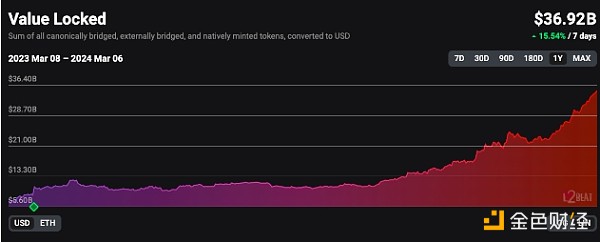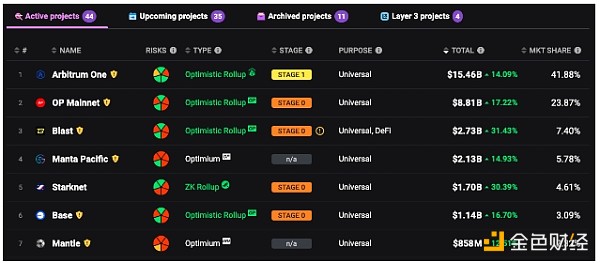Author: Tom Mitchelhill, CoinTelegraph; Compiler: Deng Tong, Golden Finance
Manta Pacific co-founder Kenny Li said that among the 44 active Ethereum Layer 2 blockchains currently in existence, " Only a few” will still be around in five years.
According to L2Beat data, There are currently 44 active Ethereum Layer2 networks with a total locked value (TVL) is US$36.92 billion, with Arbitrum (ARB) ranking first with a TVL of US$14.5 billion.
However, Manta Pacific COO and co-founder Li claimed that The future only paves the way for “modular” blockchains such as Manta, Celestia and Cosmos.
However, critics of this view argue that the term is just a "marketing gimmick" and that the network's success has nothing to do with its development methods and scalability.
"Single" BTC and ETH killer
Li believes that a large number of new Layer 2 on the Ethereum network The same path is being charted as past Bitcoin and Ethereum network “forks”, but none have “survived”.

There are 44 active Ethereum Layer 2 with a total TVL of $36 billion. Source: L2Beat
“With all the Bitcoin forks—Bitcoin Cash and BSV—they took existing technology and forked it,” Li explained road.
"They said: 'You know what. We're going to make some small changes to it. By making these small changes to it, we're going to create something 'better than Bitcoin'."
"Fast forward to 2024, and only Bitcoin is left. No other Bitcoin fork community has any comparable metrics, and no comparable community even comes close to original Bitcoin."
Li added that the same thing happened with Ethereum in 2016, when new networks such as EOS and NEO tried to position themselves as "Ethereum killers" by providing alternative EVM and VM environments that attempted to Minor adjustments to the existing Ethereum ecosystem.
In Li’s view, the core problem with all Bitcoin and Ethereum “forks” is that they are all built “monolithically,” meaning they do not allow for rapid integration and adoption over time. And new technologies emerge.
"They were all built monolithically, what happened to them, right? Fast forward to 2024. Ethereum is the dominant one."
"Will we see so many L2s in five years or so? I don't think so. Only a few will survive."
Modular blockchains are networks that derive their main tasks; execution, settlement, consensus and data availability to external blockchains, which proponents say provides greater design flexibility.
In contrast, monolithic blockchains prioritize a single-system architecture that handles all tasks within a single layer of the network.
However, some people believe that there is no reason to debate "modular vs. monolithic" at all.
Maybe this is all a "marketing gimmick"
Austin Federa, director of strategy at the Solana Foundation, will focus on these two A relatively new controversy over the term describes the introduction of Celestia as a "marketing gimmick".
While many understand Ethereum’s more “modular” architecture (relying on Layer 2 to accomplish specific tasks) as being in direct contrast to the “monolithic” nature of other higher throughput networks like Solana or Avalanche , but Federa does not fully agree with the use of this term.
“We must remember that the modular vs. monolithic debate is purely a marketing gimmick,
strong>" Federa said. "Celestia creates a distinction between modular and monolithic. It is not a natural distinction and there is nothing organic about it."
Li claims that the Manta, launched on January 18, can be described as The "first and largest" modular Layer 2 network on Ethereum because it uses Optimism's OP stack and leverages Celestia for data availability (although Ethereum co-founder Vitalik Buterin says this makes it "validium" ” instead of true L2).
As of the time of publication, Manta is the fourth largest Layer 2 network in terms of TVL, having only recently been replaced by the new Layer 2 Blast, which launched its mainnet on March 1.

Manta Pacific is the fourth largest Ethereum Layer 2 under TVL. Source: L2Beat
“We don’t build in a single way. “We don’t build any core architecture ourselves,” Li explains.
“We adopt a A very modular approach, which means we are basically able to plug and play different technologies that are available at different times so that we can continue to adapt to changing needs," Li added.
However, Federa sees no need to distinguish between the two approaches.
“The fact is that there is no such thing as a modular system , and there is no such thing as a single system. ”
Federa explained that The overall network is just an "integrated" block Chains, where tasks are handled in a single layer, whereas "modular" or "fragmented" networks accomplish the same function across multiple layers, don't actually contribute much to the success or results of a given network.< /strong>
“It’s like the words ‘pro-life’ and ‘pro-life,’ two positive interpretations of something, right? Just like no one is really pro-life or pro-choice, right? It’s just a marketing term to come up with a certain narrative that people want to talk about. ”
“I don’t think setting these things up to be inconsistent with each other is a particularly useful or accurate way to think about these systems. "They're just different software architecture choices that are not really that different in the end," Federa said.
 JinseFinance
JinseFinance
 JinseFinance
JinseFinance Weiliang
Weiliang Alex
Alex Edmund
Edmund JinseFinance
JinseFinance Brian
Brian JinseFinance
JinseFinance Brian
Brian JinseFinance
JinseFinance Kikyo
Kikyo